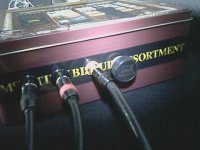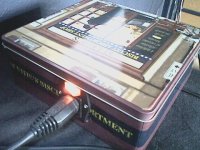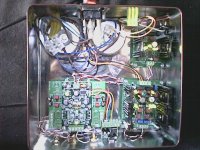Hi all,
...
As added value attenuation in the digital domain with the Buffalo (at least in the 32-bit version) is essentially a free lunch making resistor, optocoupler and transformer based attenuation entirely outdated technology. You may still need this for your analog sources, but that's a different story.
IMO
Nic
Hi,
I find digital attenuation to be very intriguing. It would seem the most simple/elegant solution of all, yet many posts seem centered on other output types, such as transformer. I'm wondering what % people go the digital (we're talking "volumite" here, right?) route. Any opinions on the pros and cons of this?
It's running
I have spent the last few hours listening to theBII with LL1674s through my headphone set-up (Castanet + Denon 1000s). First impressions - fantastic detail, excellent reproduction of voices ( Jacintha, Nora Jones, Sonny Boy Williamson on Keep It To Ourselves for starters) and very solid bass.
Great product. More to come.
Thanks to Russ and Brian.
I have spent the last few hours listening to theBII with LL1674s through my headphone set-up (Castanet + Denon 1000s). First impressions - fantastic detail, excellent reproduction of voices ( Jacintha, Nora Jones, Sonny Boy Williamson on Keep It To Ourselves for starters) and very solid bass.
Great product. More to come.
Thanks to Russ and Brian.
I have spent the last few hours listening to theBII with LL1674s through my headphone set-up (Castanet + Denon 1000s). First impressions - fantastic detail, excellent reproduction of voices ( Jacintha, Nora Jones, Sonny Boy Williamson on Keep It To Ourselves for starters) and very solid bass.
Great product. More to come.
Thanks to Russ and Brian.
It only gets better. Keep listening.
Hi,
I find digital attenuation to be very intriguing. It would seem the most simple/elegant solution of all, yet many posts seem centered on other output types, such as transformer. I'm wondering what % people go the digital (we're talking "volumite" here, right?) route. Any opinions on the pros and cons of this?
I'm going with the Volumnite route this weekend, but I will also compare it with an normal alps preamp with tube buffer. 32bits give you lots of headroom to play with for a volume controller in the digital domain....
Emile
Volumite and dual mono Buffalo2:s
Dear Russ, Brian:
with two Buffalo2:s running in dual mono, how is the Volumite used? Will one volumite control the volume on both Buffalo2:s or do I need to have two pots (=two Volumites) that each control the left respectively right channels?
Regards,
Dear Russ, Brian:
with two Buffalo2:s running in dual mono, how is the Volumite used? Will one volumite control the volume on both Buffalo2:s or do I need to have two pots (=two Volumites) that each control the left respectively right channels?
Regards,
with two Buffalo2:s running in dual mono, how is the Volumite used? Will one volumite control the volume on both Buffalo2:s or do I need to have two pots (=two Volumites) that each control the left respectively right channels?
I have a primitive question on the schematic for a "Dual Mono B-II and IVY-III" that Brain had released on TPA Support Forum before. ( Those who configure a "Dual Mono mode" must ignore the output stage wiring given on the schematic. They must reference Russ's schematic shown on this thread before instead.
http://www.diyaudio.com/forums/twisted-pear/160782-buffalo-ii-8.html#post2099315
Russ's schematic contains a correct output wiring with no phase inversion.)
In the Brain's schematic, one volumite is shared by two Buffalo II.
Is the volumite I2C master or slave?
If it is I2C slave, then microcontrollers on two Buffalo II board should be masters. In this case, two masters would conflict on one I2C bus.
If the volumite is an I2C master, then we need to remove two on-board microcontrollers. In this case, the controller on the volumite board should set all the necessary register values for a "Dual mono mode" on both ES9018 chips.
Anyway, Brian's schematic seems to need to have more explanations with it on this point.
Not ready yet?!? I already bought one of these from you....The dual mono volumite code is not ready yet.
Volumite Firmware for Buffalo-II DAC (Dual Mono), VFWBuffaloIIdm
the volumite (and others like it) IMO is about as good as attenuation gets; there is l;iterally no impact on the dataset we need for audio as far as I can tell, yes it uses bits, but we have far more bits than we actually need. I have ceased looking for other solutions. my amp and AES output is maxxed. I have a similar solution in my RME pro audio interface anyway (this is where the AES is coming from), so could really be using it instead, but I like knobs  so i've been using digital uC volume control foer years, very happy with the results and it makes impedance calcs much more manageable
so i've been using digital uC volume control foer years, very happy with the results and it makes impedance calcs much more manageable
but I like knobs
I'm using a sherry bottle cork as a knob for my Volumite (the Volumite being one of the deciding factors for going all Twisted Pear).
I built a Buffalo II, Ivy III and the Placids into a 22 x 22 x 9 (cm) McVitie's biscuit (cookie) tin. It's supposed to be temporary, but I quite like it! Its home-made look contrasts with the amazing sounds it produces.
I was just fitting a Ballsie Lite to my Buff32s today, as it will be moved to another system, to be replaced, in a little while, with a new Buff II.
Anyway, I was thinking that the Ballsie Lite has an op-amp (LME49720) and whilst it sounds fine, it is an op-amp. I was wondering if there would be any benefit from replacing it with one of those Burson Discrete types?
See the: Burson Audio DIY Products website
To be honest I don't know much about these items, and I don't want to hijack this thread, I am just seeking knowledge as it relates to the TP Ballsie.
It was also sort of related to the TP Legato and it's IC. I saw some people commenting about it not being so discrete when used in single ended mode? Would one of these Burson Discrete types be of benefit there? Or am I barking up the wrong tree?
Anyway, I was thinking that the Ballsie Lite has an op-amp (LME49720) and whilst it sounds fine, it is an op-amp. I was wondering if there would be any benefit from replacing it with one of those Burson Discrete types?
See the: Burson Audio DIY Products website
To be honest I don't know much about these items, and I don't want to hijack this thread, I am just seeking knowledge as it relates to the TP Ballsie.
It was also sort of related to the TP Legato and it's IC. I saw some people commenting about it not being so discrete when used in single ended mode? Would one of these Burson Discrete types be of benefit there? Or am I barking up the wrong tree?
I actually figured a lot of people would use the Legato for balanced output and then use a transformer for Bal/SE conversion if they wanted an op-amp free output stage.
This actually is a very good scenario because the DAC sees a near 0 ohm load, and the transformer sees a low impedance source. Both ends are happy.
Cheers!
Russ
This actually is a very good scenario because the DAC sees a near 0 ohm load, and the transformer sees a low impedance source. Both ends are happy.
Cheers!
Russ
^ haha, any pics?
I'll try to stick some up tomorrow.
Here you go. Feel free to comment/poke fun.
This is my first attempt at a DAC. It was built in a day, works perfectly and sounds fantastic.
Better versions here.
This is my first attempt at a DAC. It was built in a day, works perfectly and sounds fantastic.
Better versions here.
Attachments
passive resistor I/V
Following the advice of Erno Borbely, I do the setup for passive I/V resistor while arrives his Buffalo II & can modifie the active Borbely I/V that I have, also I have a IVY III, mine subjective opinion is:
-If you need gain, you will need an active device.
-If you have a system like mine that don't need gain the passive I/V resistor sounds incredible, less gain than IVY III but sound more live, mine advice it's people must try it & after make everyone his setup depending each own audio system.
Mine system is all full balanced & mine speakers are 94dBs.
Great product the Buffalo II.
Following the advice of Erno Borbely, I do the setup for passive I/V resistor while arrives his Buffalo II & can modifie the active Borbely I/V that I have, also I have a IVY III, mine subjective opinion is:
-If you need gain, you will need an active device.
-If you have a system like mine that don't need gain the passive I/V resistor sounds incredible, less gain than IVY III but sound more live, mine advice it's people must try it & after make everyone his setup depending each own audio system.
Mine system is all full balanced & mine speakers are 94dBs.
Great product the Buffalo II.
- Status
- This old topic is closed. If you want to reopen this topic, contact a moderator using the "Report Post" button.
- Home
- More Vendors...
- Twisted Pear
- Buffalo II



